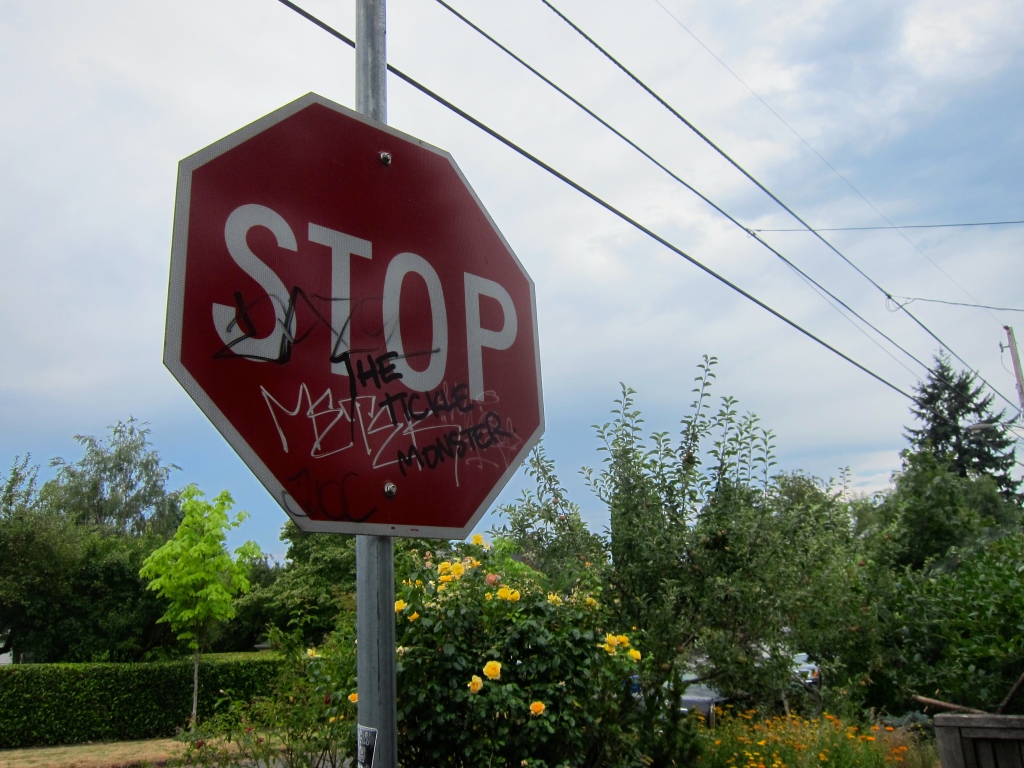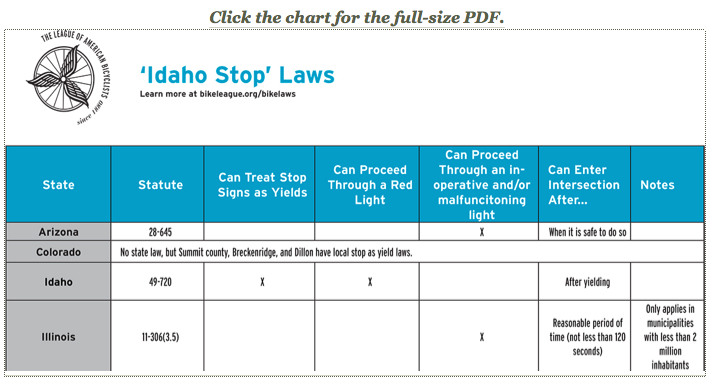How cool is it not to have to stop at stop signs? Even for this relatively law-abiding chica, it’s pretty darn cool. And I mention this because in Idaho, on a bike, you don’t actually have to stop for stop signs.
Probably most of you know this. It’s called the “Idaho stop” and it means that cyclists approaching a stop sign merely have to yield (you can read the actual statute here). Lest you think this is some new-fangled approach to cycling, this law is older than I am. And it seems to work pretty well.
 (Idaho stop: everything it’s cracked up to be. Though this is actually a Portland admonition to stop the tickle monster;)
(Idaho stop: everything it’s cracked up to be. Though this is actually a Portland admonition to stop the tickle monster;)
With every pedal stroke that brought me closer to Idaho on my last bike trip, I eagerly anticipated being able to roll through uninhabited intersections without legally having to stop — so nice when your bike weighs 50 million pounds and the inertia required to re-start is much higher.
The part that I didn’t know about the Idaho stop law, though, is that it also has a section about red lights. In Idaho, a cyclist (or anyone operating a “human-powered vehicle”) can treat red lights as stop signs. This is excellent in mitigating the fact that none of the traffic lights have sensors to detect bicycles. I found this out the annoying way, after waiting forever for several lights that only changed, finally, when a car drove up behind me. Later, when I complained to my uncle about how there was no way to get a green light for pedestrians or people on bikes, he told me the trick: just stop, then cross when it’s safe, regardless of light color.
Of course, what that law is not excellent for is necessarily ever making it safe to cross. If there’s awkwardly-spaced cross traffic and no one coming up behind you to make the light turn in your favor, the frogger-style break for it starts to seem ever more appealing the longer you wait, regardless of how safe it may or may not be. But perhaps it all works out..?
Actually, while I was looking for Idaho cyclist safety stats to see if it does all work out, I found this interesting chart about various states’ laws for stop signs and red lights. What’s interesting to me is how many different flavors of dealing with red lights there are. Check it: (there are more states shown on the full PDF)
 (from the League of American Bicyclists)
(from the League of American Bicyclists)
Anyway. I mention all this not only because I thoroughly enjoyed my time with Idaho stops (it is so much nicer to yield at an intersection), but also because it’s sort of funny to have laws like this that differ between states. I mean, I know that every state has different laws in many different arenas, but it makes for an interesting experiment in tolerance. If I hadn’t known anyone in Idaho, I might not have figured out how to cross intersections with interminable red lights, for example, but it’s more difficult the other direction: if someone from Idaho biked into the less-permissive Oregon, I can easily imagine that person running stop signs or lights without thinking she’s doing anything wrong. In Idaho, she wouldn’t have been. So is the moral onus on the user to educate herself about all potential laws before she enters a new place, or on each place to educate people about their laws?
Of course you can watch other people and pick up on habits from them, but what if you’re watching the wrong people? Someone observing traffic in, say, Portland’s Ladd’s Addition might decide that Idaho stops are legal here too, for cyclists as well as motorists — but that’s not actually the case.
Anyway. I sort of wish we’d adopt the Idaho stop thing in Oregon as well — at least, the yield at stop signs part of it — but maybe that’s a whole other post…

Love, love, love my Ideeho stops.
heh. One more perk of being in Boise, eh? ;)
The Idaho Stop laws are cool for us cyclists. The downside is that many cyclists don’t understand the law and believe they have the right-of-way regardless. I’ve seen them roll through busy intersections without stopping or yielding. This causes problems and angers motorists.
My rule for biking in Boise. When there is traffic at the light or stop sign… pretend you are a car. When there is no traffic then ride on.
You can trip lights by rolling over the sensor in the car lane. They are marked by yellow squares or you can see the cut in the road where the sensors are. They are metal detectors so stopping with a wheel on one of them “should” trip the light.
Thanks for the comment! I wondered if I could trip the car sensors, though the intersections I tried around Nampa/Meridian didn’t work for me. But I don’t remember yellow squares, so maybe I was doing it wrong:)
Now I’ll have to go back and re-investigate!
Happy riding:)